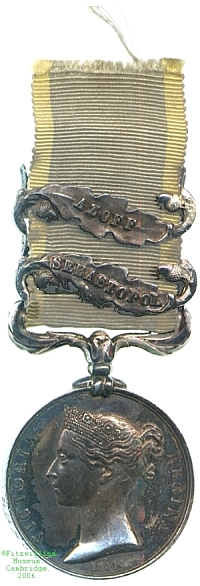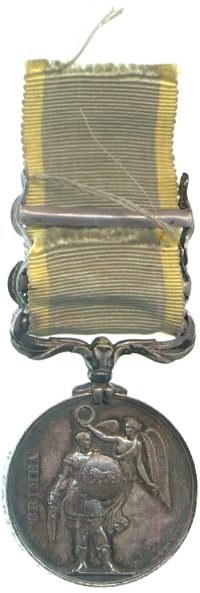
Obverse, a bust of Queen Victoria

Reverse, a Roman warrior being wreathed by the flying figure of Victory

Obverse, a bust of Queen Victoria |

Reverse, a Roman warrior being wreathed by the flying figure of Victory |
Rivalry between Britain and Russia over India, and between Russia and France over the protection of Christians under Ottoman rule, led in the 1850s to a focus of diplomatic attention on the ailing Ottoman Empire. British diplomatic successes led to a Russian attempt to annexe the Danubian principalities of Moldavia and Wallachia from the Ottomans, as well as the Russian destruction of the Ottoman Black Sea fleet when Turkey went to war in retaliation. Britain and France moved in support of the Ottomans and although the Danubian provinces were returned the allies' conditions for peace far exceeded this. The Russian refusal to meet these conditions led to full-scale international war in late 1854.
The war was mainly composed of allied attempts to reduce Russian fortresses on the Black Sea (and also on the Baltic), of which only the lengthy siege of Sevastopol was successful, but Russian attrition there and elsewhere was so heavy and the Russian ability to force withdrawal on the allies so inadequate, despite opening a second front, that Tsar Nicholas I made peace in 1856.
Between the fall of Sevastopol and the peace negotiations the main occupation of British forces was in the Sea of Azoff, where the Navy engaged in a number of inconclusive bombardments intended to lead up to the capture of Taganrog. This medal bears a bar for participation in this unsuccessful campaign, and also for action during the long siege of Sevastopol. It was awarded to Leading Stoker Richard Carter of the brig HMS Wrangler. Wrangler took part in the actions in the Sea of Azoff, where his shipmate Boatswain Joseph Kellaway earnt the Victoria Cross that he received in the first ever award of these decorations, but did not serve at Sebastopol, so to earn this bar Carter must have either fought ashore in the Naval Brigade, or else been on Wrangler only 'on loan' while his parent unit fought ashore. Lester Watson purchased his medal at some point before 1928.
The Museum gratefully acknowledges the help of Mr G. M. Stein in tracking the recipient of this medal.